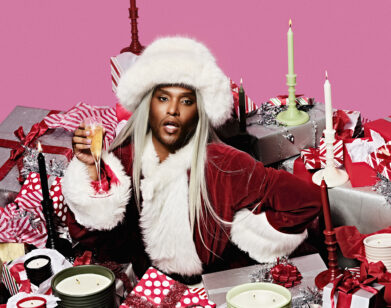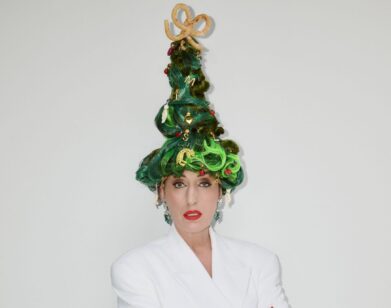Felix Burrichter Interviews Hussein Chalayan

Hussein Chalayan, photograph by Chris Moore. Still from Chalayan’s film Place to Passage (2007)
Â
Twice named British Designer of the Year, Hussein Chalayan’s clothing has a mind of its own. For his Spring 2007 collection, hemlines rose, and mechanical jackets twitched; he’s also collaborated with Swarovski on LED dresses. But above all, they’re things to be worn. Chalayan, whose office job is creative director at Puma, also makes films and installations, and his work, which is so fluid, doesn’t need a season to make sense. An exhibition of fifteen years of Chalayan’s clothing and furniture officially opens on Wednesday at London’s Design Museum. Felix Burrichter is the editor and creative director of PINâ??UP, the New York-based architecture and design magazine that gives you Zaha Hadid and Juergen Mayer and more, with humor and sometimes bondage gear. Both men have been stationed all over Europe, and here they discuss themes of identity and displacement in Chalayan’s work. Plus: Felix owns three of his very own Chalayan jackets, which he loves.
Â
Felix Burrichter: I saw the fantastic retrospective you had in Groningen, Holland, in 2005. I wonder how the new show at the Design Museum in London will be different?
Hussein Chalayan: The show in London is partly the same as the Groningen show, and it partly consists of new work. The space is very different from Groningen so it’s a different layout, but the way the mannequins engage with the space is similar.
FB: You were born in Cyprus. When did you come to London? How did you experience the city at first?
HC: I came to London when I was a year and a half for four years. Since then I have been back and forth. I do mostly feel like a Londoner: I enjoy the Angle-Saxon acceptance of difference and I feel it’s more of an integrated society than most places. But this is in London, not the rest of the UK. Most of my life has been spent in London, so I have never felt like a new arrival here. But I do have the sense of being displaced due to the frequency with which I go back and forth.
FB: You show your collections in Paris and you’ve represented Turkey at the Venice Biennale. Do you feel part of the London art and fashion scene?
Â
Â
Â
HC: Yes, I feel like part of the scene here even though I am not always physically present. Remember that the London scene consists of mostly foreigners. We see ourselves as British in many ways, but not English.
FB: What made you want to become a designer? Are there fashion designers you look up to?
HC: My interest in fashion came from my interest in the body as a central cultural figure, not from admiring other designers – but of course I love Margiela, and I love Sybilla.
FB: Which (contemporary) artists inspire you and who do you look up to? Do you collect art yourself?
HC: I love Karel Funk, Ceal Floyer, Bruce Nauman, Daniel Bischoff, Edward Lipski. I chase a few strong favorites that I can budget, but I can’t couldn’t myself a collector yet.
FB: Whom would you like to dress?
HC: I would love to dress Cindy Sherman. She would be a hard one to please because she has seen and become so many characters.
FB: I read that you use to want to become an architect at first and your designs are always beautifully structured and have many architectural elements. Did you ever think about designing a space, a house?
HC: I admire many architects-Barragan, Niemeyer, Le Corbusier, Herzog & de Meuron. And yes, I have an interest in architecture, although more theoretically than anything else. I think architecture tries to understand what the body wants to occupy, not the body itself.
Â
FB: A fascination with technology is equally present in your designs and installations – how has your new business relationship with Puma affected your design process, and has it helped your access to technology with regards to materials?
HC: Technology is the only means through which you touch on new things. There are plans to get more in depth with Puma but it’s early. Processes take a long time.
FB: In your short film “Place to Passage,” a woman travels from London to Istanbul in a vessel, which slowly fills with water like a womb as it approaches the Bosporus, Europe’s threshold to Asia-how autobiographical is this scenario, and how does it reflect your feelings towards Istanbul?
HC: It’s a situation I detect in many people form hybrid cultures, rather than feeling like it’s an autobiography. Istanbul is one of the most incredible cities in the world, and a must-see as much as London, Paris, or New York. It’s the past, present, and future, and a city where you never know what will happen from one minute to the next. It’s also a melting pot of so many cultures from that region which is so often homogenized by the nation-state.
FB: Your fashion shows always have a very strong conceptual element to them. How important is it to you to show on a runway, especially given that for a lot of designers in this economy, it’s often the first thing they re-consider.
HC: It’s not always important to do a “show,” but a live element always works better for me, unless I am making a film that goes beyond the clothes.
FB: In what is perhaps your most famous installation, “Afterwords,” three models transform their garment into pieces of furniture. What does the furniture in your own home look like?
HC: My furniture is banal and my house is pretty empty. The hardest thing to find is a sofa that is comfortable and looks good. The ones I like are never comfortable.
FB: I noticed that in all your recent collections, you almost exclusively showed mini-skirts: Are you obsessed with them?
HC: Yes, I like legs.
FB: Do you have a favorite food, and if yes, how often do you eat it, and when/where?
HC: My favorite food is artichoke-stuffed, raw, in a salad, whatever shape.
FB: What’s your personal outlook for 2009?
HC: To edit our lives, be more selective with whom we spend time and what we spend our money on. To appreciate more what we all have-we appreciate things more when we lose them.
Chalayan’s exhibition at London’s Design Museum is on view from January 22 through May 17.






